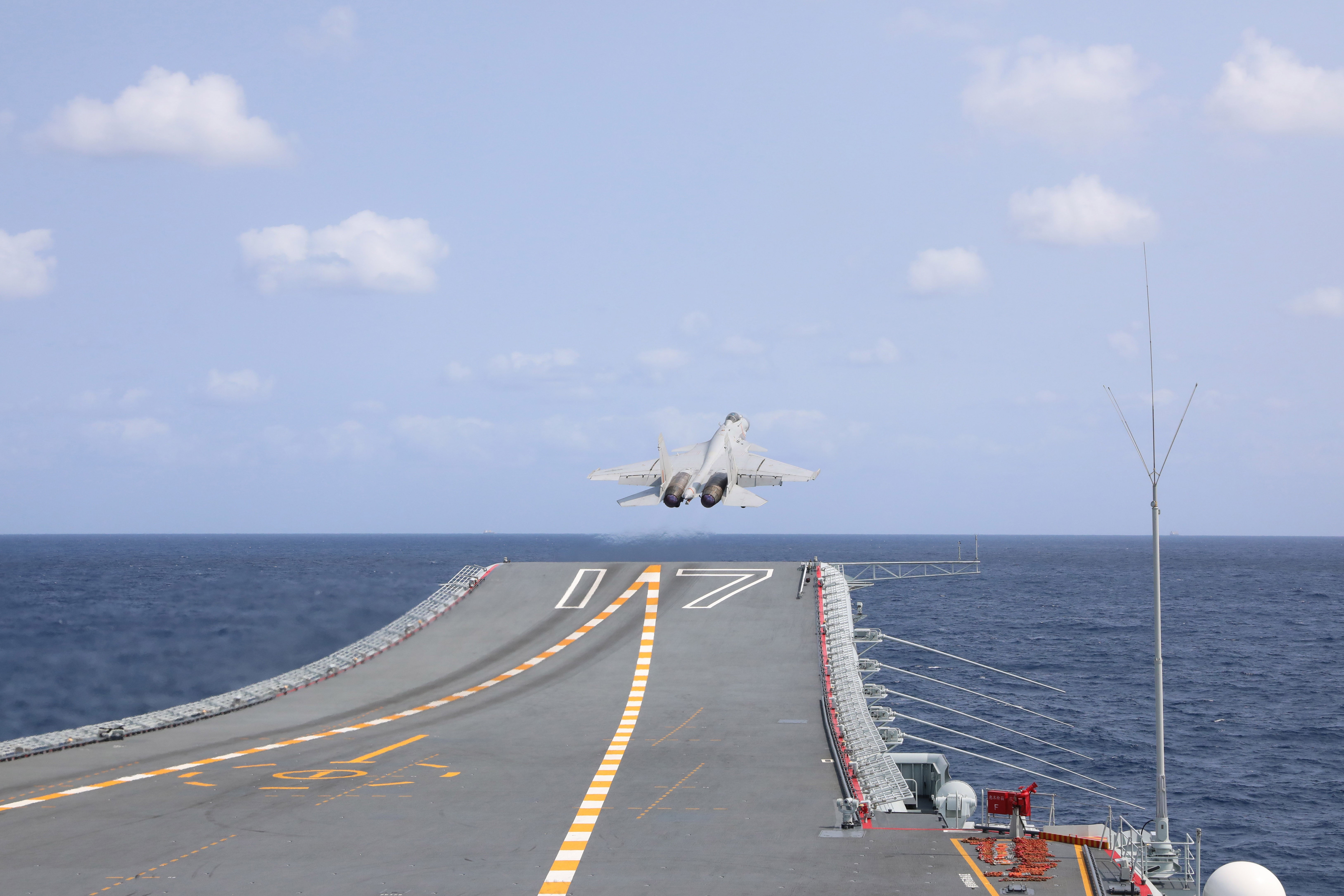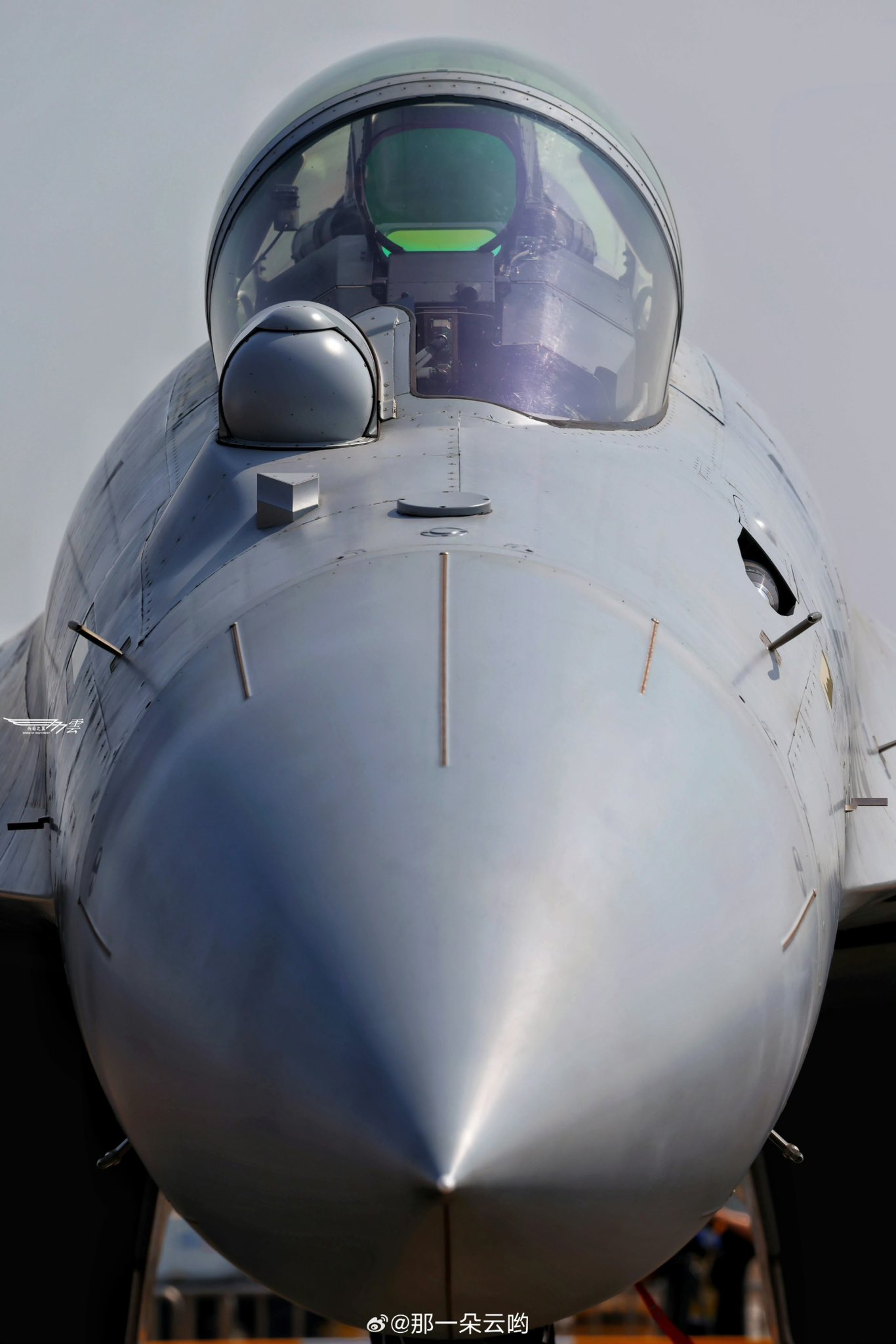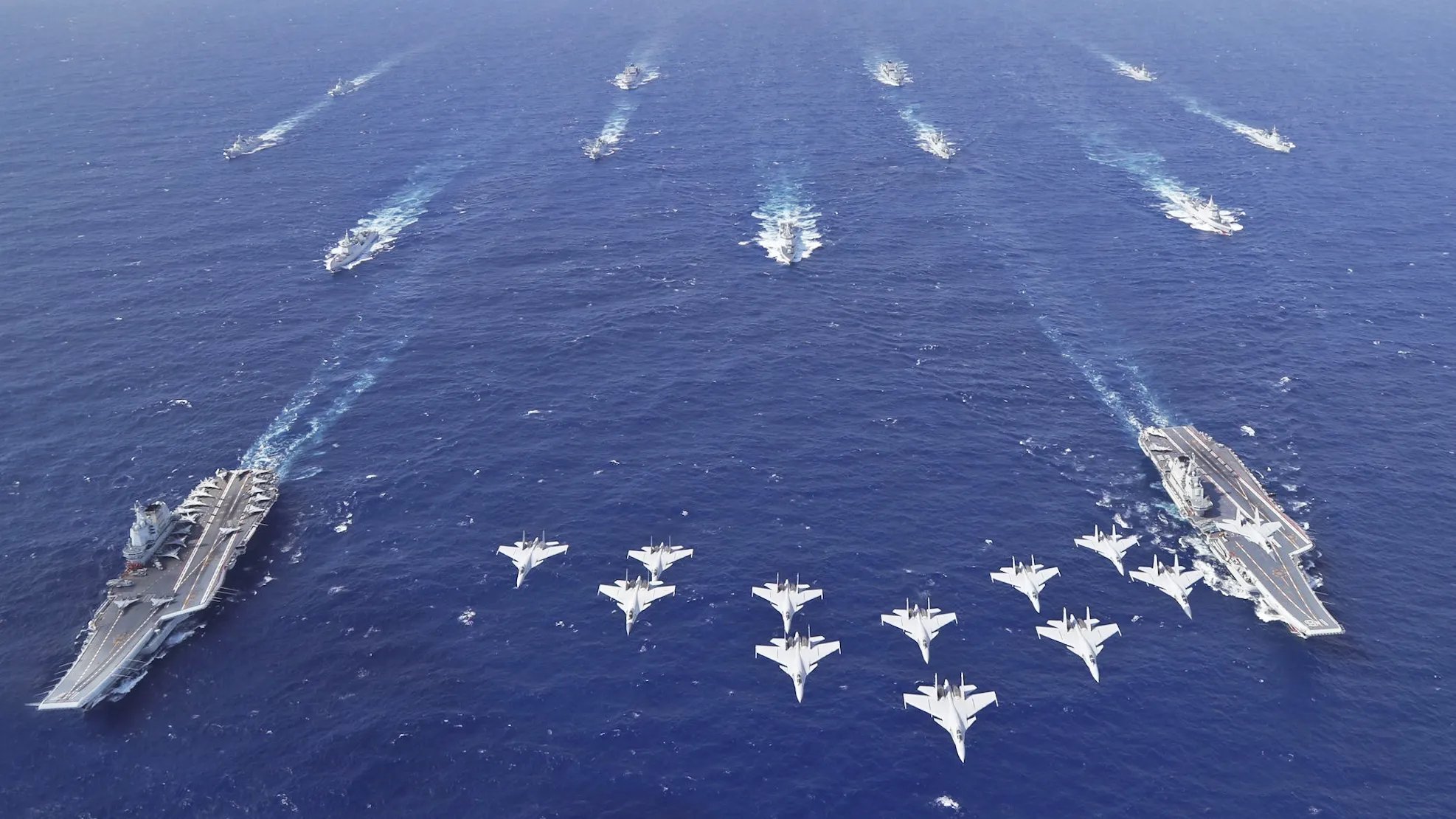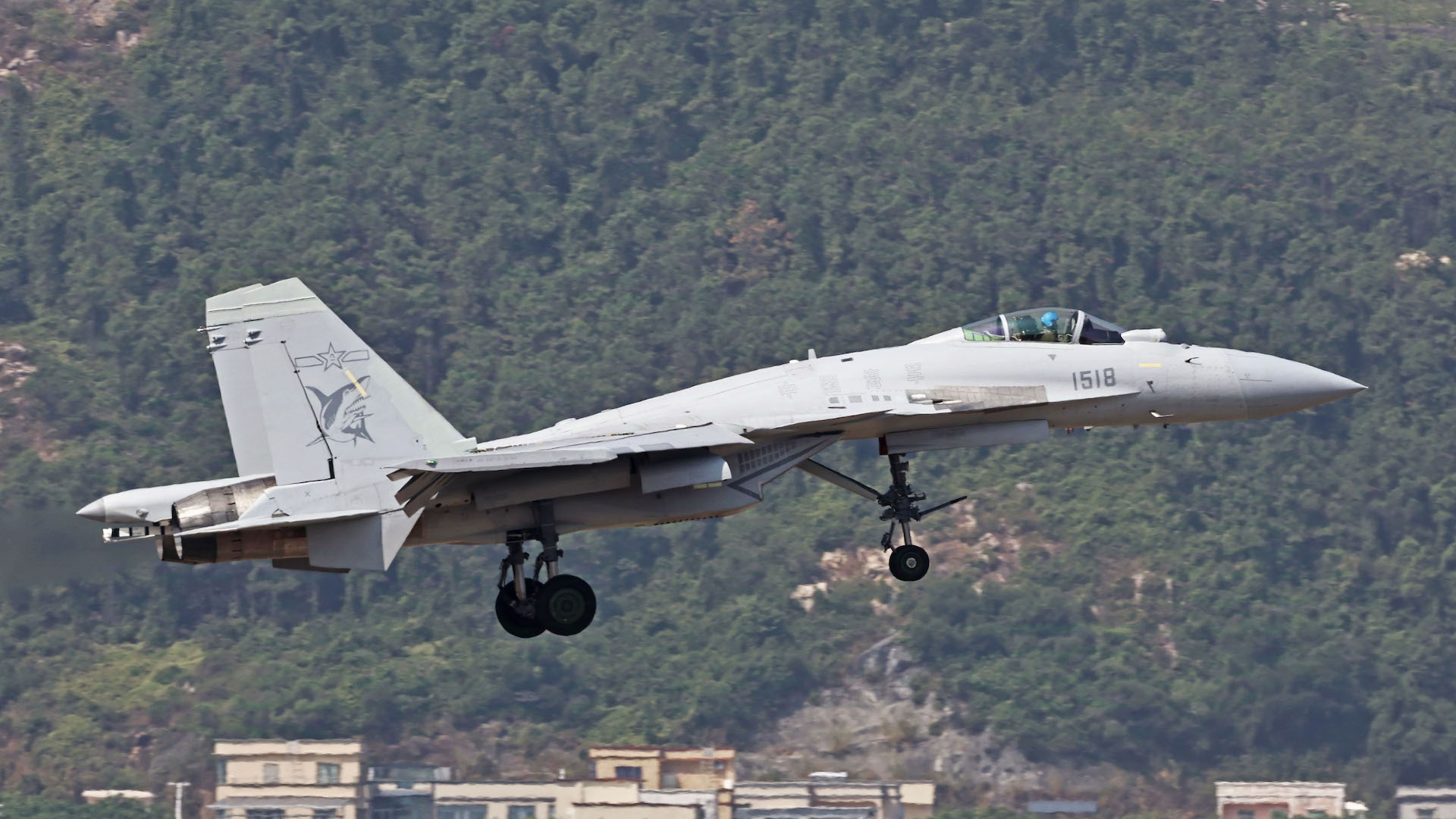China has publicly unveiled another new combat aircraft, with the arrival of the Shenyang J-15T single-seat carrier-based fighter at Zhuhai Airport for the China International Aviation & Aerospace Exhibition, better known as Airshow China, which opens next week. Just days ago, TWZ reported on the surprise appearance of the modernized naval fighter during unprecedented dual-carrier operations in the South China Sea.
The appearance of the J-15T also follows yesterday’s official public debut of the Shenyang J-35A, a land-based mediumweight stealth fighter for the People’s Liberation Army Air Force. You can read our story on that development here. The 15th edition of Airshow China will be held in Zhuhai from November 12 to 17.

Previously thought to be designated J-15B, the improved carrier-based fighter has been in development for some time, with a first flight in prototype form reported back in July 2016. The new version is primarily distinguished from the original J-15 in being equipped for catapult takeoff but assisted recovery (CATOBAR) operations, rather than short takeoff but assisted recovery (STOBAR) operations.


This means the J-15T can operate from China’s latest aircraft carrier Fujian, which is equipped with an electromagnetic aircraft launch system (EMALS).
The previous two People’s Liberation Army Navy, or PLAN aircraft carriers, the Liaoning and Shandong, both employ ‘ski-jump’ takeoff ramps to launch fixed-wing aircraft.

The J-15T — which now appears to be in operational service — will be able to operate from both CATOBAR and STOBAR carriers, although the biggest benefits will be achieved through catapult launch. This will allow the fighter to take off from the carrier with a heavier payload of fuel and weapons.
The CATOBAR features of the J-15 are clearly seen in the example at Zhuhai. They include a strengthened nose landing gear with a longer and wider shock-absorbing oleo strut and an accompanying catapult launch bar. Modifications will also have been made to the airframe to better cope with the stresses of catapult launch.
However, the J-15T will bring more capabilities, too, building significantly upon the original J-15. This, in turn, was a Chinese development of the Soviet-era Su-33 Flanker, albeit with Chinese-made avionics and weapons, but the basic design of the Su-33 traces back to the 1980s and is very much in need of modernization.
According to Andreas Rupprecht, a longtime Chinese military observer and contributor to this website, a total of 66 examples of the original J-15 were completed (in four production batches), while there are now at least 14 operational J-15T fighters, likely equivalent to low-rate initial production airframes. Added to these are at least 15 two-seat J-15S and perhaps a handful of two-seat J-15Ds for electronic warfare (not including the prototypes) — we will return to these later.
A video showing the original J-15 fighter in action aboard the aircraft carrier Liaoning:

Most surprisingly, the photos and videos of the J-15T at Zhuhai reveal that it’s fitted with domestically produced WS-10 turbofans in place of the Russian-made AL-31F engines previously found on production J-15s.
China’s long struggle to locally develop reliable and powerful turbofan engines has been well documented and, in the past, this issue was regularly identified as the Achilles’ heel of the country’s military aerospace industry.
Many key types had long relied on Russian-supplied engines, but this is now a thing of the past, with all the latest series-production J-10, J-11, J-16, and J-20 fighters using Chinese-made engines. Until now, the only exception has been the carrier-based J-15, with the Russian engines perhaps being retained as a ‘tried and tested’ solution to help mitigate the riskier aspects of carrier operations. There have also been suggestions that the Russian engine was more resilient to saltwater than the Chinese one.
After at least two J-15s were fitted with WS-10s on an experimental basis, it now appears that the turbofan has been adopted by the production-standard J-15T, which is a major development in itself, reflecting growing confidence in homegrown engines.
An earlier J-15 fitted with WS-10 engines:
Considering that the first J-15 prototype was powered by WS-10s, it seems likely that the plan was always to use these engines on production machines. In the meantime, that same prototype was apparently used to test out both EMALS and traditional steam catapults at China’s land-based carrier test facility at Huangdicun. Ultimately, EMALS was chosen for the Fujian.
Other changes are found in the J-15T’s cockpit. These include a new wide-angle holographic head-up display (HUD) as well as bars for the pilot to grab onto during catapult launches — a familiar feature of aircraft in this category.

The radome of the J-15T is different from that of the J-15, not only being a lighter gray color but having a revised shape, with a canted connection to the nose, and the pitot boom removed. The radome is understood to house a new active electronically scanned array (AESA) radar, probably the same as used on the J-11D — the ultimate Chinese version of the land-based J-11 Flanker.
The J-11D also incorporates new cockpit displays, electronic countermeasures, and communication systems some or all of which might also be ported over to the J-15T.
The radar is compatible with the latest short-range PL-10 and medium-range PL-15 air-to-air missiles, as well as a range of precision air-to-surface weapons. Previously, the J-15 relied primarily on the older PL-8 and PL-12 air-to-air missiles. You can read more about these missiles, and others, in this review of the air-to-air weapons that arm the combat aircraft of the People’s Liberation Army.

Continued Chinese development of the J-15, even while pursuing the more advanced J-35 carrier-based fighter, surprised some observers. But the fact that the J-15T can operate from all three PLAN carriers and is ready for service immediately makes it a very attractive proposition before the stealthy J-35 arrives. At the same time, it will build valuable experience within the personnel of the PLAN’s growing carrier air wing contingent. Then, once the J-35 is in service, the J-15T will also provide a very capable counterpart to the stealth jet.
The J-15T should also address any lingering concerns about the capability and reliability of the original J-15.
There have been high-profile reports of several J-15 losses, as well as questions about the safety of the baseline aircraft, which The War Zone addressed here. With that in mind, the J-15T might well have further changes to help address those reported shortcomings, which are rumored to relate primarily to an “unstable flight control system.” It might be the case that a version of the fly-by-wire flight control system used in the J-11D is also installed in the J-15T.

In CATOBAR form, the J-15T promises to finally get the most out of the impressive fuel and weapons loads that the Flanker has always been capable of carrying, but which have been strictly limited when configured for STOBAR operations. This is something that has hampered Russian Navy carrier operations, as much as Chinese ones.
As well as the J-15T, which is a multirole fighter broadly comparable with the U.S. Navy’s F/A-18E Super Hornet, China is also working on a line of two-seat carrier-compatible J-15s, to take on additional roles. While few details are available, like the J-15T, these are also expected to be compatible on both CATOBAR and STOBAR carriers.
While the J-15T is somewhat analogous to the F/A-18E, the two-seat J-15D electronic warfare aircraft is expected to operate in a role similar to the U.S. Navy’s EA-18G Growler, although it’s also thought to have a secondary strike mission. Examples of the J-15D might also have appeared on the deck of the Shandong as it conducted dual-carrier ops in the South China Sea, although we can’t be certain of that.

Finally, the PLAN also looks set to receive another two-seat J-15 broadly comparable to the F/A-18F Hornet. This is the J-15S, which remains somewhat mysterious, with suggestions that it has entered service initially as a trainer. Ultimately, however, it may be further of developed into a two-seat carrier-based multirole strike and electronic warfare platform, possibly designated J-17. This would provide the PLAN with a versatile platform that could take on a range of missions including long-range strike, air defense, and perhaps working as a command and control platform for carrier-based combat drones.
The future PLAN carrier air wing, for the Fujian, could eventually closely replicate that of the U.S. Navy, with the J-15T and J-15S in place of the F/A-18E/F, the J-15D for the EA-18G, the J-35 as an F-35C equivalent, and the KJ-600 performing the same airborne early warning and control mission as the E-2D Hawkeye. With various carrier-based drones in the works, China could also end up with a crewed/uncrewed carrier air mix similar to that being envisaged for the U.S. Navy.

In the meantime, the J-15T looks set to bring much-needed new capabilities to the PLAN’s carrier air wing, which has so far been entirely reliant on the increasingly outdated J-15 for its combat missions. Furthermore, a blend of familiarity, availability, affordability, and multirole capabilities should ensure the J-15T has a long future ahead of it on China’s three carriers, and potentially other flattops beyond those.
Contact the author: thomas@thewarzone.com
